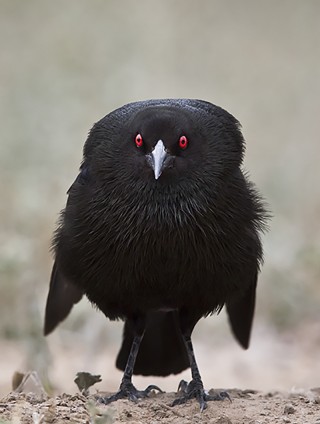
Doesn’t this bird look like it is in costume for Hallowe’en? Male Bronzed Cowbirds do a courtship display that involves puffing up their neck feathers so that they appear to have a cape. This “cape,” along with the bright red eyes, reminds us of the vampire Dracula. No wonder Bronzed Cowbirds are nicknamed “Dracula Birds.” Photo courtesy of wildlifephototour.com – Tom Whetten.
The Bronzed Cowbird is Dressed for Hallowe’en
You have to admit that this blackbird looks like he is wearing Count Dracula’s cape. And those vivid red eyes! No wonder that the Bronzed Cowbird is sometimes called the “Dracula Bird.”
Too bad the Bronzed Cowbird is not usually around this part of South Texas on October 31st. He would be quite a hit!
Bronzed Cowbirds are Central American birds that move into the border states of Texas, New Mexico, and Arizona during the breeding season. In the fall and winter they retreat to the warmer areas of Mexico and Central America. In far South Texas a few cowbirds can be found in winter, but they are not nearly as common as they are in summer.
Starting in March, Bronzed Cowbirds start showing up in flocks of Brown-headed Cowbirds and Red-winged Blackbirds that have spent the winter around here. At first there are just a few, mostly males, mixed in with the hundreds of other cowbirds and blackbirds. You have probably seen these huge flocks arching across the sky. They may have even found your feeders…which they empty in record time.
Cowbirds hang out with blackbirds because they are a type of blackbird themselves. All the blackbirds are seed-eaters generally. They feed mostly on the ground, scavenging for waste grain and weed seeds. Cowbirds, in particular, like to forage for seeds around the feet of cattle. Occasionally, a cowbird will take an insect or caterpillar if it is in front of him. Mostly, though, they prefer seeds.
Male and female Bronzed Cowbirds have the same overall body shape but the males are black, with a bronzy cast to the back, while the females are a duller color. Both have the bright red eyes. Both have the ruff of neck feathers but it is much more pronounced in the male. This ruff gives the cowbirds a thick-necked, front-heavy appearance.
In late April, the male Bronzed Cowbirds will have formed small flocks of their own kind. Frequently, a single male will have a harem of three or four females. The little group will search for food on the ground together. But the male has other things on his mind than just food. Every few minutes he will put on a remarkable display to get a female’s attention.
What he does has earned him another nickname: the “helicopter bird.” He flies up over a female and hovers a foot or two above her. She usually continues to search for food. Oberholser in The Bird Life of Texas (1974) describes the display this way: “With red eye blazing and neck-ruff puffed out, he flutters over her, often for minutes at a time, as she seemingly ignores him and continues to forage in the short grass. When the male ‘helicopter’ lands near the female, he puffs up still more. Now his neck and shoulders appear to be transformed into a sinister black cape. The female at this point is overcome—or she is frightened away, leaving the male to deflate his plumage slowly.”
If she is not frightened away by the “Dracula Bird,” the pair will mate. However, they do not go on to build a nest and raise a family.
This is because Bronzed Cowbirds, like their cousins, the Brown-headed Cowbirds, are brood parasites. They search out other birds’ nests and lay their eggs, usually singly, in them. Species often parasitized by Bronzed Cowbirds include several kinds of orioles. Altamira Orioles, Audubon’s Orioles, and Hooded Orioles (all south Texas specialties) are hosts of the Bronzed Cowbird. Orchard Orioles and Bullock’s Orioles nesting in South Texas also become victims. The unwilling, and probably unwitting, victims serve as surrogate parents for the cowbird chicks. Most often the hosts’ own chicks die as the “cuckoos in the nest” grow larger and faster than their nest mates. The unfortunate surrogate parents will continue to feed the greedy cowbird chick even when it is out of the nest. For up to two weeks, the hungry cowbird baby will beg food from its foster parents.
Eventually, the young chick will move off to feed itself and join in with other groups of cowbirds and blackbirds. I wonder how it is that they know their own kind. A lot of their behavior must be “hard-wired” into their brains. Young males seem to know instinctively how to perform that remarkable courtship display.
Which is lucky for us because it is such fun to watch! When the Bronzed Cowbirds do their Hallowe’en-like trick, we are all treated to quite a show.
If you would like to offer comments, please click through to the discussion page
